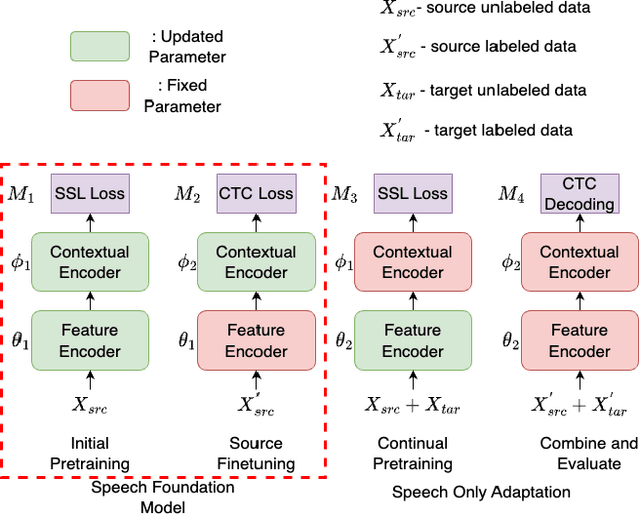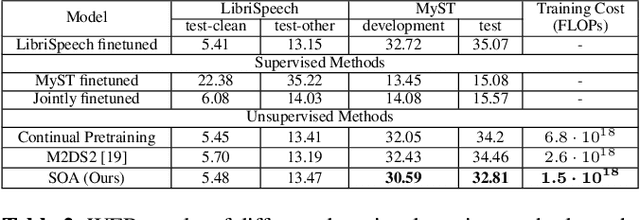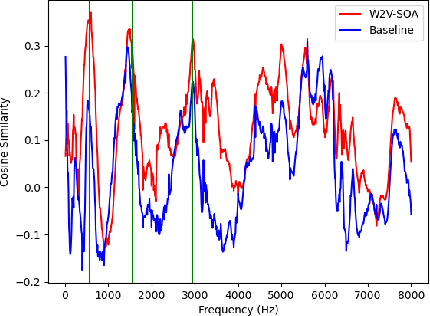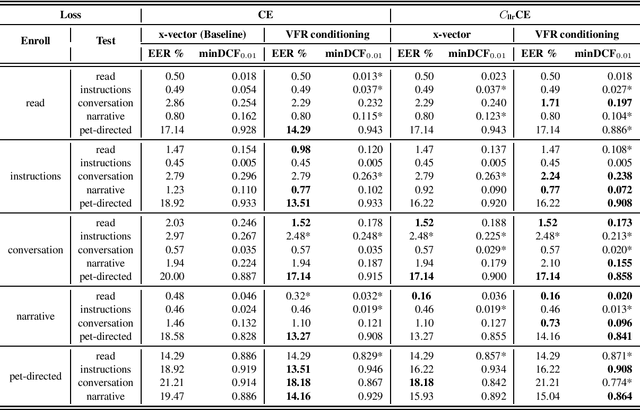Abeer Alwan
CHSER: A Dataset and Case Study on Generative Speech Error Correction for Child ASR
May 24, 2025Abstract:Automatic Speech Recognition (ASR) systems struggle with child speech due to its distinct acoustic and linguistic variability and limited availability of child speech datasets, leading to high transcription error rates. While ASR error correction (AEC) methods have improved adult speech transcription, their effectiveness on child speech remains largely unexplored. To address this, we introduce CHSER, a Generative Speech Error Correction (GenSEC) dataset for child speech, comprising 200K hypothesis-transcription pairs spanning diverse age groups and speaking styles. Results demonstrate that fine-tuning on the CHSER dataset achieves up to a 28.5% relative WER reduction in a zero-shot setting and a 13.3% reduction when applied to fine-tuned ASR systems. Additionally, our error analysis reveals that while GenSEC improves substitution and deletion errors, it struggles with insertions and child-specific disfluencies. These findings highlight the potential of GenSEC for improving child ASR.
Selective Attention Merging for low resource tasks: A case study of Child ASR
Jan 14, 2025Abstract:While Speech Foundation Models (SFMs) excel in various speech tasks, their performance for low-resource tasks such as child Automatic Speech Recognition (ASR) is hampered by limited pretraining data. To address this, we explore different model merging techniques to leverage knowledge from models trained on larger, more diverse speech corpora. This paper also introduces Selective Attention (SA) Merge, a novel method that selectively merges task vectors from attention matrices to enhance SFM performance on low-resource tasks. Experiments on the MyST database show significant reductions in relative word error rate of up to 14%, outperforming existing model merging and data augmentation techniques. By combining data augmentation techniques with SA Merge, we achieve a new state-of-the-art WER of 8.69 on the MyST database for the Whisper-small model, highlighting the potential of SA Merge for improving low-resource ASR.
Benchmarking Children's ASR with Supervised and Self-supervised Speech Foundation Models
Jun 15, 2024Abstract:Speech foundation models (SFMs) have achieved state-of-the-art results for various speech tasks in supervised (e.g. Whisper) or self-supervised systems (e.g. WavLM). However, the performance of SFMs for child ASR has not been systematically studied. In addition, there is no benchmark for child ASR with standard evaluations, making the comparisons of novel ideas difficult. In this paper, we initiate and present a comprehensive benchmark on several child speech databases based on various SFMs (Whisper, Wav2vec2.0, HuBERT, and WavLM). Moreover, we investigate finetuning strategies by comparing various data augmentation and parameter-efficient finetuning (PEFT) methods. We observe that the behaviors of these methods are different when the model size increases. For example, PEFT matches the performance of full finetuning for large models but worse for small models. To stabilize finetuning using augmented data, we propose a perturbation invariant finetuning (PIF) loss as a regularization.
SOA: Reducing Domain Mismatch in SSL Pipeline by Speech Only Adaptation for Low Resource ASR
Jun 15, 2024



Abstract:Recently, speech foundation models have gained popularity due to their superiority in finetuning downstream ASR tasks. However, models finetuned on certain domains, such as LibriSpeech (adult read speech), behave poorly on other domains (child or noisy speech). One solution could be collecting as much labeled and diverse data as possible for joint finetuning on various domains. However, collecting target domain speech-text paired data and retraining the model is often costly and computationally expensive. In this paper, we introduce a simple yet effective method, speech only adaptation (SOA), based on speech foundation models (Wav2vec 2.0), which requires only speech input data from the target domain. Specifically, the Wav2vec 2.0 feature encoder is continually pretrained with the Wav2vec 2.0 loss on both the source and target domain data for domain adaptation, while the contextual encoder is frozen. Compared to a source domain finetuned model with the feature encoder being frozen during training, we find that replacing the frozen feature encoder with the adapted one provides significant WER improvements to the target domain while preserving the performance of the source domain. The effectiveness of SOA is examined on various low resource or domain mismatched ASR settings, including adult-child and clean-noisy speech.
UniEnc-CASSNAT: An Encoder-only Non-autoregressive ASR for Speech SSL Models
Feb 14, 2024


Abstract:Non-autoregressive automatic speech recognition (NASR) models have gained attention due to their parallelism and fast inference. The encoder-based NASR, e.g. connectionist temporal classification (CTC), can be initialized from the speech foundation models (SFM) but does not account for any dependencies among intermediate tokens. The encoder-decoder-based NASR, like CTC alignment-based single-step non-autoregressive transformer (CASS-NAT), can mitigate the dependency problem but is not able to efficiently integrate SFM. Inspired by the success of recent work of speech-text joint pre-training with a shared transformer encoder, we propose a new encoder-based NASR, UniEnc-CASSNAT, to combine the advantages of CTC and CASS-NAT. UniEnc-CASSNAT consists of only an encoder as the major module, which can be the SFM. The encoder plays the role of both the CASS-NAT encoder and decoder by two forward passes. The first pass of the encoder accepts the speech signal as input, while the concatenation of the speech signal and the token-level acoustic embedding is used as the input for the second pass. Examined on the Librispeech 100h, MyST, and Aishell1 datasets, the proposed UniEnc-CASSNAT achieves state-of-the-art NASR results and is better or comparable to CASS-NAT with only an encoder and hence, fewer model parameters. Our codes are publicly available.
Non-uniform Speaker Disentanglement For Depression Detection From Raw Speech Signals
Jun 06, 2023Abstract:While speech-based depression detection methods that use speaker-identity features, such as speaker embeddings, are popular, they often compromise patient privacy. To address this issue, we propose a speaker disentanglement method that utilizes a non-uniform mechanism of adversarial SID loss maximization. This is achieved by varying the adversarial weight between different layers of a model during training. We find that a greater adversarial weight for the initial layers leads to performance improvement. Our approach using the ECAPA-TDNN model achieves an F1-score of 0.7349 (a 3.7% improvement over audio-only SOTA) on the DAIC-WoZ dataset, while simultaneously reducing the speaker-identification accuracy by 50%. Our findings suggest that identifying depression through speech signals can be accomplished without placing undue reliance on a speaker's identity, paving the way for privacy-preserving approaches of depression detection.
Towards Better Domain Adaptation for Self-supervised Models: A Case Study of Child ASR
Apr 28, 2023



Abstract:Recently, self-supervised learning (SSL) from unlabelled speech data has gained increased attention in the automatic speech recognition (ASR) community. Typical SSL methods include autoregressive predictive coding (APC), Wav2vec2.0, and hidden unit BERT (HuBERT). However, SSL models are biased to the pretraining data. When SSL models are finetuned with data from another domain, domain shifting occurs and might cause limited knowledge transfer for downstream tasks. In this paper, we propose a novel framework, domain responsible adaptation and finetuning (DRAFT), to reduce domain shifting in pretrained speech models, and evaluate it for a causal and non-causal transformer. For the causal transformer, an extension of APC (E-APC) is proposed to learn richer information from unlabelled data by using multiple temporally-shifted sequences to perform prediction. For the non-causal transformer, various solutions for using the bidirectional APC (Bi-APC) are investigated. In addition, the DRAFT framework is examined for Wav2vec2.0 and HuBERT methods, which use non-causal transformers as the backbone. The experiments are conducted on child ASR (using the OGI and MyST databases) using SSL models trained with unlabelled adult speech data from Librispeech. The relative WER improvements of up to 19.7% on the two child tasks are observed when compared to the pretrained models without adaptation. With the proposed methods (E-APC and DRAFT), the relative WER improvements are even larger (30% and 19% on the OGI and MyST data, respectively) when compared to the models without using pretraining methods.
A CTC Alignment-based Non-autoregressive Transformer for End-to-end Automatic Speech Recognition
Apr 15, 2023



Abstract:Recently, end-to-end models have been widely used in automatic speech recognition (ASR) systems. Two of the most representative approaches are connectionist temporal classification (CTC) and attention-based encoder-decoder (AED) models. Autoregressive transformers, variants of AED, adopt an autoregressive mechanism for token generation and thus are relatively slow during inference. In this paper, we present a comprehensive study of a CTC Alignment-based Single-Step Non-Autoregressive Transformer (CASS-NAT) for end-to-end ASR. In CASS-NAT, word embeddings in the autoregressive transformer (AT) are substituted with token-level acoustic embeddings (TAE) that are extracted from encoder outputs with the acoustical boundary information offered by the CTC alignment. TAE can be obtained in parallel, resulting in a parallel generation of output tokens. During training, Viterbi-alignment is used for TAE generation, and multiple training strategies are further explored to improve the word error rate (WER) performance. During inference, an error-based alignment sampling method is investigated in depth to reduce the alignment mismatch in the training and testing processes. Experimental results show that the CASS-NAT has a WER that is close to AT on various ASR tasks, while providing a ~24x inference speedup. With and without self-supervised learning, we achieve new state-of-the-art results for non-autoregressive models on several datasets. We also analyze the behavior of the CASS-NAT decoder to explain why it can perform similarly to AT. We find that TAEs have similar functionality to word embeddings for grammatical structures, which might indicate the possibility of learning some semantic information from TAEs without a language model.
A Step Towards Preserving Speakers' Identity While Detecting Depression Via Speaker Disentanglement
Jun 29, 2022



Abstract:Preserving a patient's identity is a challenge for automatic, speech-based diagnosis of mental health disorders. In this paper, we address this issue by proposing adversarial disentanglement of depression characteristics and speaker identity. The model used for depression classification is trained in a speaker-identity-invariant manner by minimizing depression prediction loss and maximizing speaker prediction loss during training. The effectiveness of the proposed method is demonstrated on two datasets - DAIC-WOZ (English) and CONVERGE (Mandarin), with three feature sets (Mel-spectrograms, raw-audio signals, and the last-hidden-state of Wav2vec2.0), using a modified DepAudioNet model. With adversarial training, depression classification improves for every feature when compared to the baseline. Wav2vec2.0 features with adversarial learning resulted in the best performance (F1-score of 69.2% for DAIC-WOZ and 91.5% for CONVERGE). Analysis of the class-separability measure (J-ratio) of the hidden states of the DepAudioNet model shows that when adversarial learning is applied, the backend model loses some speaker-discriminability while it improves depression-discriminability. These results indicate that there are some components of speaker identity that may not be useful for depression detection and minimizing their effects provides a more accurate diagnosis of the underlying disorder and can safeguard a speaker's identity.
Learning from human perception to improve automatic speaker verification in style-mismatched conditions
Jun 28, 2022


Abstract:Our prior experiments show that humans and machines seem to employ different approaches to speaker discrimination, especially in the presence of speaking style variability. The experiments examined read versus conversational speech. Listeners focused on speaker-specific idiosyncrasies while "telling speakers together", and on relative distances in a shared acoustic space when "telling speakers apart". However, automatic speaker verification (ASV) systems use the same loss function irrespective of target or non-target trials. To improve ASV performance in the presence of style variability, insights learnt from human perception are used to design a new training loss function that we refer to as "CllrCE loss". CllrCE loss uses both speaker-specific idiosyncrasies and relative acoustic distances between speakers to train the ASV system. When using the UCLA speaker variability database, in the x-vector and conditioning setups, CllrCE loss results in significant relative improvements in EER by 1-66%, and minDCF by 1-31% and 1-56%, respectively, when compared to the x-vector baseline. Using the SITW evaluation tasks, which involve different conversational speech tasks, the proposed loss combined with self-attention conditioning results in significant relative improvements in EER by 2-5% and minDCF by 6-12% over baseline. In the SITW case, performance improvements were consistent only with conditioning.
 Add to Chrome
Add to Chrome Add to Firefox
Add to Firefox Add to Edge
Add to Edge